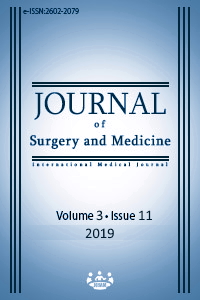Evaluation of changes in myelination in the brain during infancy and childhood using ADC maps
Keywords:
Myelination, Diffusion weighted imaging, Magnetic resonance imaging, Apparent diffusion coefficientAbstract
Aim: Myelinization has a critical role in achieving rapid synchronization between the neural system and high-grade cognitive functions. Because of this critical role, it is important to quantitatively determine the degree of myelination. Today, structural changes due to myelination can be evaluated quantitatively by diffusion magnetic resonance imaging (MRI) and apparent diffusion coefficient (ADC) measurements. The aim of this study was to evaluate myelination-related changes in different regions of the brain during infancy and childhood in the normal population by measuring ADC values in routine MRI examinations.
Methods: In this cross-sectional study, 109 patients aged 0-17 years who underwent brain MRI examination with 3.0T device and whose myelination and maturation were interpreted as normal in conventional sequences were evaluated. In all examinations, ADC maps from 30 different locations were evaluated and measured in the workstation based on T2-weighted images.
Results: There is a functional relationship between ADC values and the myelination process during infancy and childhood in the normal population. ADC values decrease in all localizations with increasing age, especially during the first 2 years. During the postnatal period, ADC values, which are higher in the white matter, decrease as maturation of white matter is completed and increase in the cortical gray matter. No significant difference was found between bilateral structures except the thalamus, caudate nucleus or centrum semiovale regions. There was no gender-dependent significant difference in the patients aged between zero and 2 years.
Conclusion: ADC values for each localization can be easily obtained by diffusion weighted imaging and ADC maps, which are frequently used in routine MRI examinations. The relationship between ADC values and myelination process can be revealed in the whole brain and normative values can be obtained for multiple regions in the brain.
Downloads
References
Helen M. Branson. Normal Myelination A Practical Pictorial Review. Neuroimaging Clin N Am. 2013;183-95.
Bird CR, Hedberg M, Drayer BP, Keller PJ, Flom RA, Hodak JA. MR assessment of myelination in infants and children: usefulness of marker sites. AJNR Am J Neuroradiol. 1989;10:731–40.
Barkovich AJ, Kjos BO, Jackson DE Jr, Norman D. Normal maturation of the neonatal and infant brain: MR imaging at 1.5T. Radiology. 1988;166:173–80.
Baykan A, Ateşoğlu Karabaş S , Doğan Z , Solgun S , Özcan G , Şahin Ş, et al. Assessment of age- and sex-dependent changes of cerebellum volume in healthy individuals using magnetic resonance imaging. Journal of Surgery and Medicine. 2019;3(7):481-4.
Dietrich RB, Bradley WG, Zaragoza EJ IV, Otto RJ, Taira RK, Wilson GH, et al. MR evaluation of early myelination patterns in normal and developmentally delayed infants. AJR Am J Roentgenol. 1988;150:889–96
Deoni SC, Mercure E, Blasi A, Gasston D, Thomson A, Johnson M, et al. Mapping infant brain myelination with magnetic resonance imaging. J Neurosci. 2011;31(2):784–91.
Helenius J, Soinne L, Perkiö J, Salonen O, Kangasmaki A, Kaste M, et al. Diffusion-Weighted MR Imaging in Normal Human Brains in Various Age Groups. Am J Neuroradiol. 2002;23(2):194-9.
Mori S, Barker PB. Diffusion magnetic resonance imaging: its principle and applications. Anat Rec. 1999;257(3):102-9.
Yoshida S, Oishi K, Fairia AV, Mori S. Diffusion tensor imaging of normal brain development. Pediatr Radiol. 2013;43:15–27.
Jones RA, Palasis S, Grattan-Smith JD. The Evolution of the Apparent Diffusion Coefficient in the Pediatric Brain at Low and High Diffusion Weightings. Journal Of Magnetic Resonance Imaging. 2003;18:665–74.
Neil JJ, Shiran SI, McKinstry RC, Schefft GL, Snyder AZ, Almli CR, et al. Normal brain in human newborns: apparent diffusion coefficient and diffusion anisotropy measured by using diffusion tensor MR imaging. Radiology. 1998;209:57-66.
Huppi PS, Maier SE, Peled S, Zientara GP, Barnes PD, Jolesz FA, et al. Microstructural development of human newborn cerebral white matter assessed in vivo by diffusion tensor magnetic resonance imaging. Pediatr Res. 1998;44:584–90.
Kehrer M, Blumenstock G, Ehehalt S, Goelz R, Poets C, Schoning M. Development of cerebral blood flow volume in preterm neonates during the first two weeks of life. Pediatr Res. 2005;58:927–30.
Han R, Huang L, Sun Z, Zhang D, Chen X, Yang X, et al. Assessment of apparent diffusion coefficient of normal fetal brain development from gestational age week 24 up to term age: a preliminary study. Fetal Diagn Ther. 2015;37:102–7.
Bültmann E, Joachim H, Zapf A, Hartmann H, Nagele T, Lanferman H. Changes in brain microstructure during infancy and childhood using clinical feasible ADC-maps. Childs Nerv Syst. 2017;33:735–45.
Schneider JF, Confort-Gouny S, Le Fur Y, Viout P, Bennathan M, Chapon F, et al. Diffusion weighted imaging in normal fetal brain maturation. Eur Radiol. 2007;17:2422–9.
Coats JS, Freeberg A, Pajela EG, Obenaus A, Ashwal S. Meta-analysis of apparent diffusion coefficients in the newborn brain. Pediatr Neurol. 2009;41:263–74.
Engelbrecht V, Scherer A, Rassek M, Witsack HJ, Modder U. Diffusion weighted MR imaging in the brain in children: findings in the normal brain and in the brain with white matter diseases. Radiology. 2002;222:410–8.
Downloads
- 1061 1548
Published
Issue
Section
How to Cite
License
Copyright (c) 2019 Mustafa Özkan, İsmail Taşkent, Memik Teke
This work is licensed under a Creative Commons Attribution-NonCommercial-NoDerivatives 4.0 International License.
















